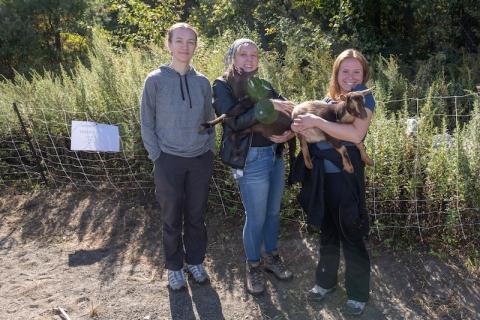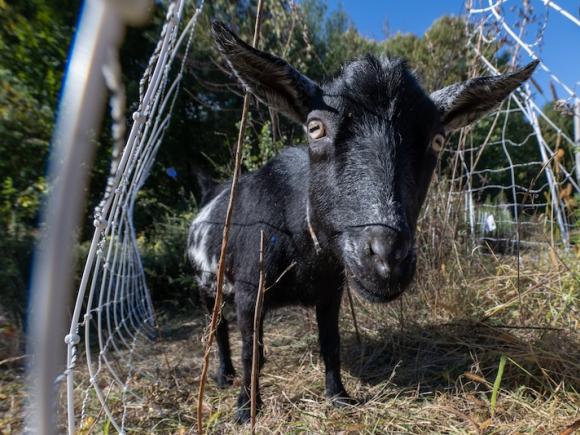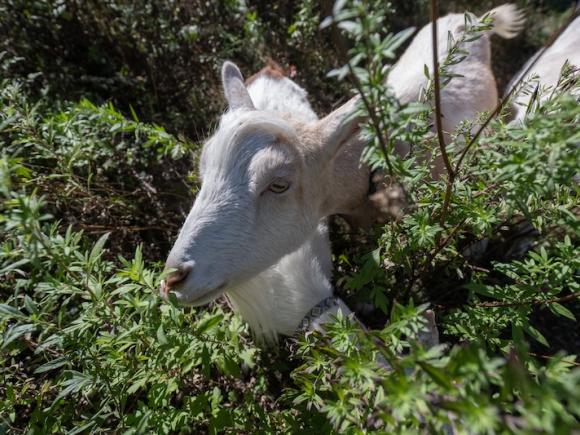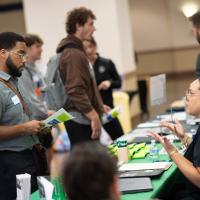
University Students Use Goatscaping to Tackle Invasive Plants on Campus

Lindsey Dion, Sophia Milko, and Abbey Majka.
Three Westfield State University environmental science majors are taking an innovative approach to combating invasive plant species on campus. For their Senior Capstone Project, Sophia Milko, Lindsey Dion, and Abbey Majka, who is also double majoring in regional planning and has a concentration in environmental planning, are using goats to "goatscape" the area near South Lot. Goatscaping is a centuries-old and historically recognized method of landscaping and involves using goats to eat invasive plants that threaten local ecosystems.
Milko, who grew up on Nightingale Acres in Central Massachusetts, was inspired by her childhood experience working with goats. Her family regularly used them to remove harmful plants like poison ivy from their property. Now, she's bringing her passion for environmental science and animals to campus, where the team will target invasive species such as Oriental Bittersweet, a fast-growing vine that can suffocate trees.
“It’s becoming such a common plant for our area, so we’re trying to see if we can find a better solution to remove it because it grows back really fast,” Milko explained. “We want to see if having the goats digest the plant and its seeds will make it harder.”
Because goats have a four-chamber stomach that easily digest a variety of plants, they’ve historically been recognized as one of the most cost-efficient and eco-friendly ways to remove invasive plants from the environment. Since invasive species decrease biodiversity and often have tough defense systems, goatscaping can be a way to ensure plant removal since the plants do not affect the animals in adverse ways.
Invasive species can be introduced to ecosystems by being transported across oceans by accident, or on purpose for aesthetic purposes, such as the Japanese Knotweed, Majka added. “As an ornamental plant, a lot of them go crazy because there’s no natural predators for them anymore. These plants have evolved to out-compete each other, and so it’ll compete with everything else around them, too.”
To carry out their plan, the students partnered with Cindy Williams, owner of Goatee Goat Acres in Chicopee and an alumna of Westfield State. Williams will provide the goats for the project, which will focus on clearing the area around South Lot.



The idea for the project came to Milko early in her time at the University, where she noticed a wetland research area overrun with invasive species. “When I first came to the University, I noticed we had a research area that was a little bit of a wetland, and it was covered in invasives,” she said. “I asked one of my professors about potentially getting goats on the property to remove them and if that’d already been done before, which it hasn’t. So, for our Senior Capstone Project, I brought it up.”
With assistance from faculty from the department, Milko, Dion, and Majka began preparations for the rigorous process of arranging it all, which took about 4-5 weeks in total. The goats have also been trained to remain within a solar-powered electric fence that will keep them confined to the designated area. “Goats are escape artists,” Milko joked. “They climb anything, so they had to go through training to get used to the fence and make sure they don’t go up to it.”
During the project itself, the goats will be monitored throughout the day and be housed off-site for rest during the night. The project will also analyze how goatscaping compares with the manual removal of invasive species at a similar location.
The project already has support from the environmental science department, with their professors cheering them on. Additionally, they’ve received a lot of assistance from the University’s grounds crew, who the students describe as “amazing”. The grounds crew will be providing a water tub to help keep the goats watered throughout the project.
“I'm super excited about the project,” Dion added. “I've learned a lot about invasive plant species during my time in college and how incredibly stubborn they are. I had never heard of using goats to remove invasives before Sophie told me about the project idea, so I'm overjoyed to get to expand my skills and knowledge in this area. We're really hoping that this project will give us a way to efficiently remove invasives and pave the way for future goat projects on campus.”
“The department is a close-knit community,” Milko shared. “There’s a lot of us, but at the same time, it’s close and you don’t go a day without seeing your friends and professors. It’s a really warm and welcoming environment. It’s nice to have people standing behind you and supporting your projects. We’re all so excited and happy.”


